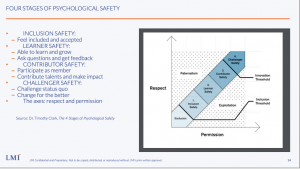While it’s easy to think of mental health as just a personal concern, the reality is that a person’s psychological well-being is also the responsibility of the organization that they work for. As we have witnessed a global pandemic and renewed focus on persistent racial disparities in our country, it has become more apparent than ever that a workplace needs to be a safe and welcoming environment where everyone feels comfortable.
But for many, the workplace can still be a major source of anxiety and unease. When people do not feel valued, respected or prioritized, there are both personal and professional costs. On the recent NextGen online training, “Psychological Safety in the Workplace,” Mel Kepler and Rachel Niebeling, two experts from government consulting firm LMI, shared how to foster a healthy work environment at both an individual and organizational level.
One workplace priority is comfort. Do team members feel comfortable making jokes? Do they feel comfortable offering respectful, constructive criticism to each other? These are signs of a workplace where people feel safe psychologically. Another important question to ask, Kepler noted, is whether coworkers know things about one another’s lives outside of the office, and feel able to discuss such matters.
So, having established what psychological safety at work looks like, how can you tell when it is not present?
Kepler and Niebeling presented this in terms of cost. In a psychologically unsafe environment, Kepler said, the cost of making a stand on an issue or even doing something as simple as asking for guidance is perceived to be too high. This means suffering, both personal and professional. In an environment like this, people may dread coming to work, and no team can run smoothly or efficiently if fear or discomfort rule the workplace.
They also noted that perceptions of psychological safety can vary widely across individuals on a single team. This is influenced by several factors, such as an individual’s place in the organizational hierarchy, their background and identity, and experiences.
Those in management positions, or those who hold privileged racial or gender identities, may default to a higher level of psychological safety, but need to be aware that how they feel may not be reflective of how other individuals on their team feel. As Kepler put it: “As a unit, you can only be as safe as the least safe person.”
So how can someone—a manager, an individual, a team—prioritize and cultivate psychological safety? Here are some strategies:
For anyone:
- Understand the four stages of psychological safety:

For managers:
- Ensure that hierarchy does not define interpersonal relationships. This means that it should not just be junior employees learning from senior employees, but a collaborative environment where everyone feels comfortable sharing their ideas and opinions.
- Control your behavior. As a manager, you set the tone for your team, and while it is often impossible to dictate the behavior of others, one thing you can always control is your own tendencies and reactions. Lead by example and create a friendly, open, non-judgmental environment.
- As Kepler said, “if you meet with someone for 30 minutes, listen for 20.” As a manager, you need to be able to hear the concerns of those working for you. Only then can you address them.
For individuals:
- Make individual connections. These heighten the overall psychological safety of the team, which is the sum of how comfortable each employee feels with every other employee. By forming a connection with any one person, you move the needle on overall team comfort.
- Be understanding. As Niebeling said, “people are fighting battles every day that you don’t know about”. Before offering criticism or judgement, think about what might be influencing a person’s behavior and what an appropriate response would be.
- Be a rock. Even in a dysfunctional, psychologically unsafe team, you can be psychologically safe for other team members. By providing a safe space for them, you are taking a small step toward a better environment, and may be just the lifeline they need.
Header Photo by Christina @ wocintechchat.com
Want to attend free online trainings like this one? Pre-register for all of the 2021 NextGen webinars!





Leave a Reply
You must be logged in to post a comment.